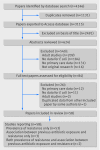Global prevalence of antibiotic resistance in paediatric urinary tract infections caused by Escherichia coli and association with routine use of antibiotics in primary care: systematic review and meta-analysis
- PMID: 26980184
- PMCID: PMC4793155
- DOI: 10.1136/bmj.i939
Global prevalence of antibiotic resistance in paediatric urinary tract infections caused by Escherichia coli and association with routine use of antibiotics in primary care: systematic review and meta-analysis
Abstract
Objectives: To systematically review studies investigating the prevalence of antibiotic resistance in urinary tract infections caused by Escherichia coli in children and, when appropriate, to meta-analyse the relation between previous antibiotics prescribed in primary care and resistance.
Design and data analysis: Systematic review and meta-analysis. Pooled percentage prevalence of resistance to the most commonly used antibiotics in children in primary care, stratified by the OECD (Organisation for Economic Co-operation and Development) status of the study country. Random effects meta-analysis was used to quantify the association between previous exposure to antibiotics in primary care and resistance.
Data sources: Observational and experimental studies identified through Medline, Embase, Cochrane, and ISI Web of Knowledge databases, searched for articles published up to October 2015.
Eligibility criteria for selecting studies: Studies were eligible if they investigated and reported resistance in community acquired urinary tract infection in children and young people aged 0-17. Electronic searches with MeSH terms and text words identified 3115 papers. Two independent reviewers assessed study quality and performed data extraction.
Results: 58 observational studies investigated 77,783 E coli isolates in urine. In studies from OECD countries, the pooled prevalence of resistance was 53.4% (95% confidence interval 46.0% to 60.8%) for ampicillin, 23.6% (13.9% to 32.3%) for trimethoprim, 8.2% (7.9% to 9.6%) for co-amoxiclav, and 2.1% (0.8 to 4.4%) for ciprofloxacin; nitrofurantoin was the lowest at 1.3% (0.8% to 1.7%). Resistance in studies in countries outside the OECD was significantly higher: 79.8% (73.0% to 87.7%) for ampicillin, 60.3% (40.9% to 79.0%) for co-amoxiclav, 26.8% (11.1% to 43.0%) for ciprofloxacin, and 17.0% (9.8% to 24.2%) for nitrofurantoin. There was evidence that bacterial isolates from the urinary tract from individual children who had received previous prescriptions for antibiotics in primary care were more likely to be resistant to antibiotics, and this increased risk could persist for up to six months (odds ratio 13.23, 95% confidence interval 7.84 to 22.31).
Conclusions: Prevalence of resistance to commonly prescribed antibiotics in primary care in children with urinary tract infections caused by E coli is high, particularly in countries outside the OECD, where one possible explanation is the availability of antibiotics over the counter. This could render some antibiotics ineffective as first line treatments for urinary tract infection. Routine use of antibiotics in primary care contributes to antimicrobial resistance in children, which can persist for up to six months after treatment.
Published by the BMJ Publishing Group Limited. For permission to use (where not already granted under a licence) please go to http://group.bmj.com/group/rights-licensing/permissions.
Conflict of interest statement
Competing interests: All authors have completed the ICMJE uniform disclosure form at
Figures




Comment in
-
Antibiotic resistance in children with E coli urinary tract infection.BMJ. 2016 Mar 15;352:i1399. doi: 10.1136/bmj.i1399. BMJ. 2016. PMID: 26980716 Free PMC article.
References
Publication types
MeSH terms
Substances
Grants and funding
LinkOut - more resources
Full Text Sources
Other Literature Sources
Medical
